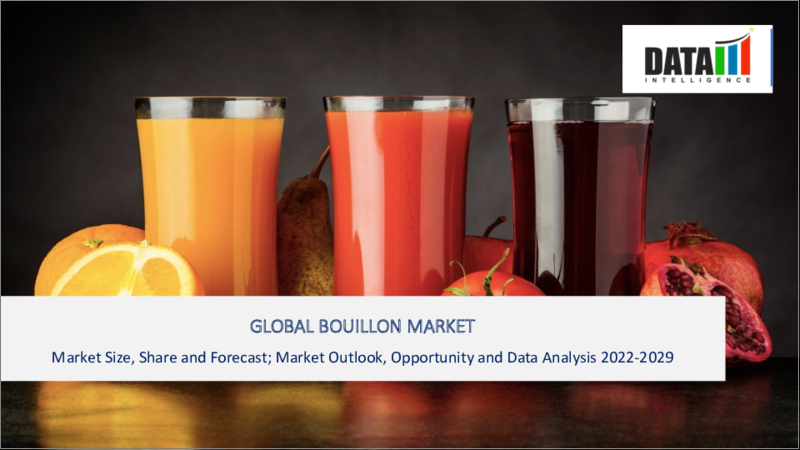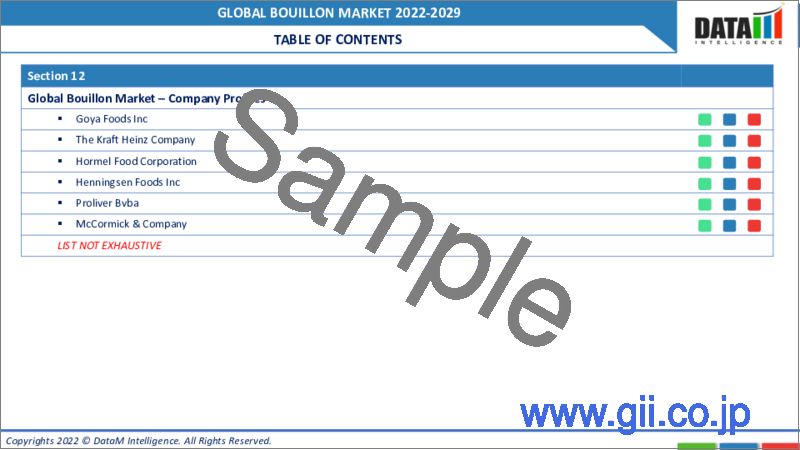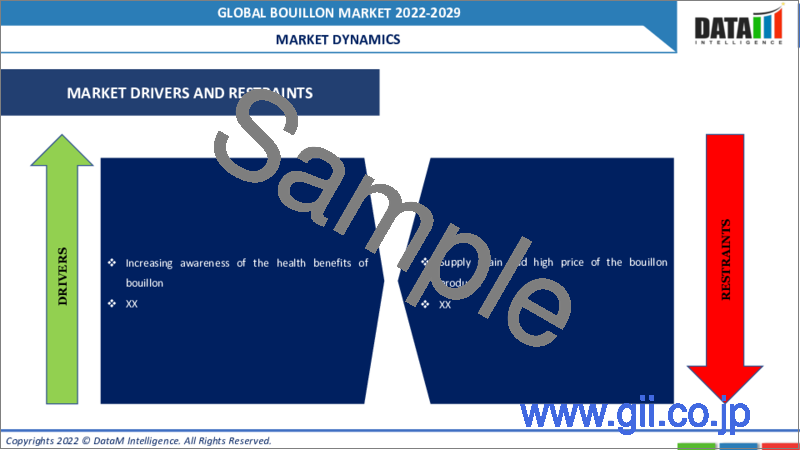|
|
市場調査レポート
商品コード
1107834
ブイヨンの世界市場(2022年~2029年)Global Bouillon Market - 2022-2029 |
||||||
|
● お客様のご希望に応じて、既存データの加工や未掲載情報(例:国別セグメント)の追加などの対応が可能です。 詳細はお問い合わせください。 |
|||||||
| ブイヨンの世界市場(2022年~2029年) |
|
出版日: 2022年07月31日
発行: DataM Intelligence
ページ情報: 英文 170 Pages
納期: 約2営業日
|
- 全表示
- 概要
- 目次
世界のブイヨンの市場規模は、キューブブイヨンの耐久性、調理の容易さ、代替品に対する消費者の嗜好などによって促進されています。
当レポートでは、世界のブイヨン市場を調査しており、市場の概要、市場規模や予測、動向、成長要因および課題、顧客情勢、形態・製品・流通チャネル・地域別の分析、さら企業プロファイルなどを提供しています。
目次
範囲と調査手法
- 調査手法
- 市場の範囲
第2章 主な動向と発展
第3章 エグゼクティブサマリー
- 形態別の市場内訳
- 製品別の市場内訳
- 流通チャネル別の市場内訳
- 地域別の市場内訳
第4章 市場力学
- 市場に影響を与える要因
- 促進要因
- 抑制要因
- 機会
- 影響分析
第5章 業界分析
- ポーターのファイブフォース分析
- バリューチェーン分析
- 特許分析
- 規制分析
第6章 COVID-19分析
- 市場におけるCOVID-19の分析
- COVID-19以前の市場シナリオ
- 現在のCOVID-19市場シナリオ
- COVID-19後または将来のシナリオ
- COVID-19の中での価格変動
- 需給スペクトル
- パンデミック時の市場に関連する政府の取り組み
- メーカーの戦略的イニシアチブ
第7章 形態別
- イントロダクション
- 形態別の市場規模分析、および前年比成長分析
- 形態別の市場魅力指数
- キューブ*
- イントロダクション
- 市場規模分析(2020年~2029年、および前年比成長分析、2021年~2029年)
- 液体
- 粉末
- 顆粒
- その他
第8章 製品別
- イントロダクション
- 製品別の市場規模分析、および前年比成長分析
- 製品別の市場魅力指数
- 野菜
- イントロダクション
- 市場規模分析(2020年~2029年、および前年比成長分析、2021年~2029年)
- 魚
- 肉
- その他
第9章 流通チャネル別
- イントロダクション
- 流通チャネル別の市場規模分析、および前年比成長分析
- 流通チャネル別の市場魅力指数
- オフライン
- イントロダクション
- 市場規模分析(2020年~2029年、および前年比成長分析、2021年~2029年)
- オンライン
第10章 地域別
- イントロダクション
- 地域別の市場規模分析、および前年比成長率分析
- 地域別の市場魅力指数
- 北米
- イントロダクション
- 主要な地域固有のダイナミクス
- 形態別の市場規模分析、および前年比成長率分析
- 製品別の市場規模分析、および前年比成長率分析
- 用途別の市場規模分析、および前年比成長率分析
- 流通チャネル別の市場規模分析、および前年比成長率分析
- 国別の市場規模分析、および前年比成長率分析
- 南米
- イントロダクション
- 主要な地域固有のダイナミクス
- 形態別の市場規模分析、および前年比成長率分析
- 製品別の市場規模分析、および前年比成長率分析
- 用途別の市場規模分析、および前年比成長率分析
- 流通チャネル別の市場規模分析、および前年比成長率分析
- 国別の市場規模分析、および前年比成長率分析
- 欧州
- イントロダクション
- 主要な地域固有のダイナミクス
- 形態別の市場規模分析、および前年比成長率分析
- 製品別の市場規模分析、および前年比成長率分析
- 用途別の市場規模分析、および前年比成長率分析
- 流通チャネル別の市場規模分析および前年比成長率分析
- 国別の市場規模分析、および前年比成長率分析
- アジア太平洋
- イントロダクション
- 主要な地域固有のダイナミクス
- 形態別の市場規模分析、および前年比成長率分析
- 製品別の市場規模分析、および前年比成長率分析
- 用途別の市場規模分析、および前年比成長率分析
- 流通チャネル別の市場規模分析、および前年比成長率分析
- 国別の市場規模分析、および前年比成長率分析
- 中東とアフリカ
- イントロダクション
- 主要な地域固有のダイナミクス
- 形態別の市場規模分析、および前年比成長率分析
- 製品別の市場規模分析、および前年比成長率分析
- 用途別の市場規模分析、および前年比成長率分析
- 流通チャネル別の市場規模分析、および前年比成長率分析
第11章 競合情勢
- 競合シナリオ
- 競合他社の戦略分析
- 市場ポジショニング/シェア分析
- 合併と買収の分析
第12章 企業プロファイル
- Nestle S.A*
- 企業概要
- 製品ポートフォリオ・種類
- 主要ハイライト
- 財務概要
- International Dehydrated Foods Inc
- The Unilever Group
- Southern Mills,Inc
- Goya Foods Inc
- The Kraft Heinz Company
- Hormel Food Corporation
- Henningsen Foods Inc
- Proliver Bvba
- McCormick & Company
第13章 データM
- 付録
- 弊社とサービスについて
- お問い合わせ
Market Overview
The global bouillon market was valued at USD XX million in 2021. It is forecasted to reach USD XX million by 2029, growing at a CAGR of XX% during the forecast period (2022-2029).
Bouillon is also known as broth. Bouillon is made with water, bones, meat, or vegetables that have been cooked in a heated liquid. It can be eaten on its own, although it is most commonly used to prepare soups, gravies, and sauces. Vitamins and nutrients such as calcium and magnesium are abundant in bouillon. Dehydrating meat, fish, poultry, and beef can also be used to make a bouillon. It is accessible both online and in physical stores. Bouillon comes in various forms, including liquid, cubes, and powder. It aids in the protection of joints and the treatment of osteoarthritis. The popularity of bouillon cubes is growing due to durability, ease of preparation, and the availability of various products in cube form. Furthermore, customer preference for an alternative to reducing the use of refrigerators for storage is predicted to enhance the usage of bouillon cubes.
Market Dynamics:
Increasing awareness of the health benefits of bouillon
Consumers worldwide are becoming increasingly aware of bouillon's health benefits, including reduced cardiovascular disease risk, improved glucose tolerance, lower blood pressure, and lower plasma glucose levels. It contains several biologically active components, including antimicrobial properties. Bouillon flavonoids can help prevent obesity, diabetes, and heart disease, among other things. Its weight-loss benefits are expected to attract many customers, fueling market expansion. Diabetes was the seventh leading cause of mortality in 2016, according to research published by the World Health Organization (WHO). According to the Cancer Prevention Research Journal, bouillon extract can accelerate the death of some lung cancer cells.
Furthermore, due to its anti-inflammatory, anti-aging, and other qualities, bouillon plays an important role in preserving the skin from UV damage. Due to these benefits, Bouillon has become a popular ingredient in skin care products such as creams, lotions, serums, toners, and cleansers. Bouillon also helps to preserve the skin from aging. The polyphenols in bouillon help prevent the development of free radicals, which can damage the skin's network of cells while also promoting skin health. As a result of the increased use of bouillon extracts in the cosmetics industry, the boullion market is predicted to rise faster in the coming years.
Market Segmentation:
Cube accounted for the highest share in global bouillon market
The global market can be divided into cube, liquid, powder, gel, and crystal segments. In 2021, cube products accounted for the majority of market share, with a value of USD XX billion. This is due to the working population's significant intake of pre-packaged, easy-to-cook, and healthful bouillon food. Furthermore, new products with additional flavours and ingredients are gaining appeal among the younger population, which is likely to boost the market for bouillon cubes.
During the projection period, vegetable products are expected to grow at the fastest rate of XX percent. This is due to the wide range of vegan bouillon products available in liquid, gel, semi-liquid, and cube form. Furthermore, healthy attributes like as gluten-free, lactose-free, cholesterol-free, and fat-free may increase market demand for vegetable bouillon products. Vegetarian eating preferences among the youthful population in industrialized North American countries such as the United States and Canada are expected to enhance demand for vegetarian bouillon products in the future years.
Geographical Penetration:
Europe is the dominating region during the forecast period
Europe dominates the bouillon market due to rise in the awareness regarding health benefits of bouillon products, rise in the inclination towards healthy eating habits among people and changing lifestyle of people and inclination towards consumption of easy to make and healthy food products in this region.
As the population in emerging nations such as India, China, and Bangladesh adopt western culture of living and working, the market in Asia Pacific and Rest of the World offers attractive opportunities for new segments. As a result, it has the potential to increase demand for cube and liquid products in these countries. Furthermore, rising health awareness, combined with a hectic working lifestyle due to women's economic independence, is predicted to boost demand in Asia Pacific, Central & South America, and Middle East & Africa.
Competitive Landscape:
The market is competitive with the presence of many private level brands. Nestle S.A., International Dehydrated Foods, Inc., The Unilever Group, McCormick & Company, Incorporated, Henningsen Foods, Inc., Southern Mills, Inc., Proliver Bvba, and Goya Foods, Inc. are the major companies in this industry. To gain a larger market share, the corporations are developing new product designs based on recent consumer preferences for flavour and health benefits.
COVID-19 Impact:
Negative impact on the global bouillon market
The COVID-19 (coronavirus) pandemic wreaks havoc on society and the global economy. The pandemic's influence is expanding daily, affecting the supply chain. The COVID-19 situation is causing stock market anxiety, a major slowdown in supply chains, a drop in corporate confidence, and an increase in panic among customer segments. Companies that manufacture and sell bouillon are having production problems. The coronavirus has caused factories to close, the supply chain to be completely disrupted, and enterprises to have difficulties with raw material availability and a shortage of employees and resources, all of which have hampered worldwide market growth.
The global bouillon market report would provide an access to approximately 61 market data tables, 54 figures and 170 pages
Table of Contents
Scope and Methodology
- 1.1. Research Methodology
- 1.2. Scope of the Market
2. Key Trends and Developments
3. Executive Summary
- 3.1. Market Snippet by Form
- 3.2. Market Snippet by Product
- 3.3. Market Snippet by Distribution Channel
- 3.4. Market Snippet by Region
4. Market Dynamics
- 4.1. Market impacting factors
- 4.1.1. Drivers
- 4.1.2. Restraints
- 4.1.3. Opportunities
- 4.2. Impact analysis
5. Industry Analysis
- 5.1. Porter's five forces analysis
- 5.2. Value chain analysis
- 5.3. Patent Analysis
- 5.4. Regulatory Analysis
6. COVID-19 Analysis
- 6.1. Analysis of Covid-19 on the Market
- 6.1.1. Before COVID-19 Market Scenario
- 6.1.2. Present COVID-19 Market Scenario
- 6.1.3. After COVID-19 or Future Scenario
- 6.2. Pricing Dynamics Amid Covid-19
- 6.3. Demand-Supply Spectrum
- 6.4. Government Initiatives Related to the Market During Pandemic
- 6.5. Manufacturers Strategic Initiatives
7. By Form
- 7.1. Introduction
- 7.1.1. Market size analysis, and y-o-y growth analysis (%), By Form Segment
- 7.1.2. Market attractiveness index, By Form Segment
- 7.2. Cube*
- 7.2.1. Introduction
- 7.2.2. Market Size Analysis, US$ Million, 2020-2029 And Y-O-Y Growth Analysis (%), 2021-2029
- 7.3. Liquid
- 7.4. Powder
- 7.5. Granules
- 7.6. Others
8. By Product
- 8.1. Introduction
- 8.1.1. Market size analysis, and y-o-y growth analysis (%), By Product Segment
- 8.1.2. Market attractiveness index, By Product Segment
- 8.2. Vegetables
- 8.2.1. Introduction
- 8.2.2. Market Size Analysis, US$ Million, 2020-2029 And Y-O-Y Growth Analysis (%), 2021-2029
- 8.3. Fish
- 8.4. Meat
- 8.5. Others
9. Bullion Market-By Distribution Channel
- 9.1. Introduction
- 9.1.1. Market size analysis, and y-o-y growth analysis (%), By Distribution Channel Segment
- 9.1.2. Market attractiveness index, By Distribution Channel Segment
- 9.2. Offline
- 9.2.1. Introduction
- 9.2.2. Market Size Analysis, US$ Million, 2020-2029 And Y-O-Y Growth Analysis (%), 2021-2029
- 9.3. Online
10. By Region
- 10.1. Introduction
- 10.1.1. Market Size Analysis, And Y-O-Y Growth Analysis (%), By Region
- 10.1.2. Market Attractiveness Index, By Region
- 10.2. North America
- 10.2.1. Introduction
- 10.2.2. Key region-specific dynamics
- 10.2.3. Market Size Analysis, And Y-O-Y Growth Analysis (%), By Form
- 10.2.4. Market Size Analysis, And Y-O-Y Growth Analysis (%), By Product
- 10.2.5. Market Size Analysis, And Y-O-Y Growth Analysis (%), By Application
- 10.2.6. Market Size Analysis, And Y-O-Y Growth Analysis (%), By Distribution Channel
- 10.2.7. Market Size Analysis, And Y-O-Y Growth Analysis (%), By Country
- 10.2.7.1. U.S.
- 10.2.7.2. Canada
- 10.2.7.3. Mexico
- 10.3. South America
- 10.3.1. Introduction
- 10.3.2. Key Region-Specific Dynamics
- 10.3.3. Market Size Analysis, And Y-O-Y Growth Analysis (%), By Form
- 10.3.4. Market Size Analysis, And Y-O-Y Growth Analysis (%), By Product
- 10.3.5. Market Size Analysis, And Y-O-Y Growth Analysis (%), By Application
- 10.3.6. Market Size Analysis, And Y-O-Y Growth Analysis (%), By Distribution Channel
- 10.3.7. Market Size Analysis, And Y-O-Y Growth Analysis (%), By Country
- 10.3.7.1. Brazil
- 10.3.7.2. Argentina
- 10.3.7.3. Rest of South America
- 10.4. Europe
- 10.4.1. Introduction
- 10.4.2. Key Region-Specific Dynamics
- 10.4.3. Market Size Analysis, And Y-O-Y Growth Analysis (%), By Form
- 10.4.4. Market Size Analysis, And Y-O-Y Growth Analysis (%), By Product
- 10.4.5. Market Size Analysis, And Y-O-Y Growth Analysis (%), By Application
- 10.4.6. Market Size Analysis, And Y-O-Y Growth Analysis (%), By Distribution Channel
- 10.4.7. Market Size Analysis, And Y-O-Y Growth Analysis (%), By Country
- 10.4.7.1. Germany
- 10.4.7.2. U.K.
- 10.4.7.3. France
- 10.4.7.4. Spain
- 10.4.7.5. Italy
- 10.4.7.6. Rest of Europe
- 10.5. Asia Pacific
- 10.5.1. Introduction
- 10.5.2. Key Region-Specific Dynamics
- 10.5.3. Market Size Analysis, And Y-O-Y Growth Analysis (%), By Form
- 10.5.4. Market Size Analysis, And Y-O-Y Growth Analysis (%), By Product
- 10.5.5. Market Size Analysis, And Y-O-Y Growth Analysis (%), By Application
- 10.5.6. Market Size Analysis, And Y-O-Y Growth Analysis (%), By Distribution Channel
- 10.5.7. Market Size Analysis, And Y-O-Y Growth Analysis (%), By Country
- 10.5.7.1. China
- 10.5.7.2. India
- 10.5.7.3. Japan
- 10.5.7.4. Australia
- 10.5.7.5. Rest of Asia Pacific
- 10.6. Middle East and Africa
- 10.6.1. Introduction
- 10.6.2. Key Region-Specific Dynamics
- 10.6.3. Market Size Analysis, And Y-O-Y Growth Analysis (%), By Form
- 10.6.4. Market Size Analysis, And Y-O-Y Growth Analysis (%), By Product
- 10.6.5. Market Size Analysis, And Y-O-Y Growth Analysis (%), By Application
- 10.6.6. Market Size Analysis, And Y-O-Y Growth Analysis (%), By Distribution Channel
11. Competitive Landscape
- 11.1. Competitive scenario
- 11.2. Competitor strategy analysis
- 11.3. Market positioning/share analysis
- 11.4. Mergers and acquisitions analysis
12. Company Profiles
- 12.1. Nestle S.A*
- 12.1.1. Company Overview
- 12.1.2. Product Portfolio and Description
- 12.1.3. Key Highlights
- 12.1.4. Financial Overview
- 12.2. International Dehydrated Foods Inc
- 12.3. The Unilever Group
- 12.4. Southern Mills,Inc
- 12.5. Goya Foods Inc
- 12.6. The Kraft Heinz Company
- 12.7. Hormel Food Corporation
- 12.8. Henningsen Foods Inc
- 12.9. Proliver Bvba
- 12.10. McCormick & Company
- List not Exhaustive*
13. DataM
- 13.1. Appendix
- 13.2. About us and services
- 13.3. Contact us




